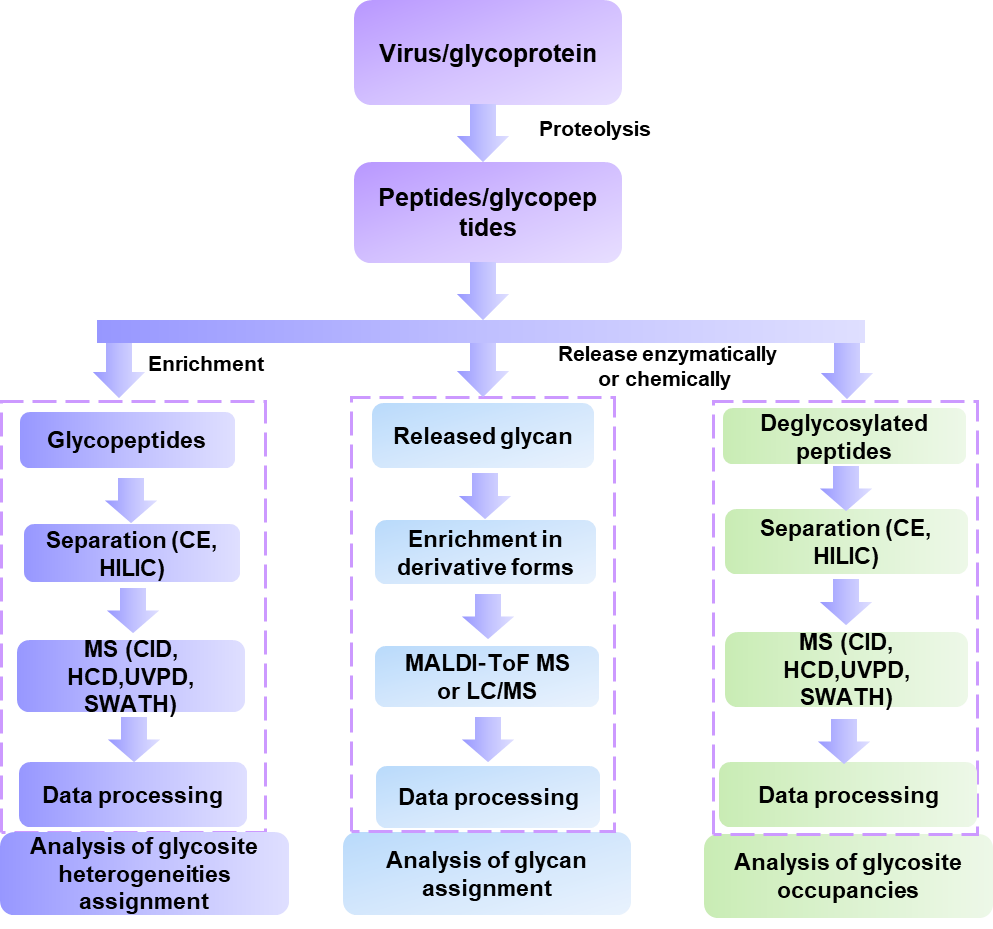MS-Based Analysis of Viral Glycoproteomics
Recent Ebola virus, Zika virus, and SARS-CoV-2 epidemics have urged for robust reaction to these unpredictable global health challenges. To achieve these goals, characterization of viral glycoproteins is very important, including their structure, function and immunological properties. The advances in mass spectrometry (MS) have made a substantial contribution in robustly investigating the composition and location of glycans on viral envelope glycoproteins. Modern mass spectrometry(MS)-based methods of analysis have paved the way for functional studies on the biological effects of glycosylation on viruses. Based on a range of MS techniques, Creative Proteomics is capable of providing the first-rate service of viral glycoproteomics analysis for our global customers.
MS in the analysis of viral glycoprotein glycosylation
MS is a pivotal technique and has been widely used for the analysis of glycosylation on viral envelope glycoproteins. Based on MS, the structure of glycoprotein can be identified, the site-specific glycan can be characterized. Matrix-assisted laser desorption/ionization mass spectrometry (MALDI-MS) is one of the most commonly used tools in glycan analysis. MALDI-MS combined with lectin microarray is able to provide a more reliable characterization of the glycan structure. Permethylation of glycans can enhance the sensitivity of MALDI-MS-based detection due to it can greatly increase the ionization efficiency of glycans. In addition, electrospray ionization mass spectrometry (ESI-MS) and tandem (MSn) mass spectrometry fragmentation techniques can be used to further characterize the structure of the selected chitosan ions, allowing differentiation between "isobaric" glycans. And liquid chromatography-MSn (LC-MSn) provides greater advantages for obtaining the information of fragmentation as well as structural determination of isomers. In recent, LC with a better separation system and trapped ion mobility spectrometry (TIMS) was reported to differentiate the isomers of permethylated glycans.
Service offering
Glycoproteomics is the systematic study of glycans linked to proteins or peptides. The analysis of glycoproteomics is based on a glycopeptide-centric bottom-up approach that glycoproteins, where glycoproteins are digested into (glyco)peptides and then analyzed by MS. Due to the low content and wide dynamic range of glycated proteins in biological samples, glycoproteins need to be enriched to improve their abundance before performing MS. There are several separation techniques, including capillary electrophoresis (CE), hydrophilic interaction chromatography (HILIC), and ion mobility. We offer a new generation of combined MS to determine intact glycopeptides of complex glycoprotein and subsequently analyze the MS data using specific software.
The workflow of our services
Based on professional scientists and advanced instruments, we can achieve glycoprotein glycosylation analysis, including the analysis of glycosite heterogeneities assignment, glycan assignment, glycosite occupancies, and so on.

How to order?

The MS-based analysis is an attractive analytical strategy that provides intact glycopeptide analysis, thus providing direct evidence for the site-specific glycosylation of proteins. Our services enable the identification of N-glycosylation sites and O-glycosylation sites of viral glycoprotein, the analysis of the localization and composition of corresponding site-specific glycan, and so on. If you are interested in our services, please don't hesitate to contact us. We are glad to cooperate with you and witness your success!
References
- Cipollo, J. F., & Parsons, L. M. (2020). “Glycomics and glycoproteomics of viruses: Mass spectrometry applications and insights toward structure–function relationships.” Mass Spectrometry Reviews, 39(4), 371-409.
- Hargett, A. A., & Renfrow, M. B. (2019). “Glycosylation of viral surface proteins probed by mass spectrometry.” Current opinion in virology, 36, 56-66.
* For research use only.


